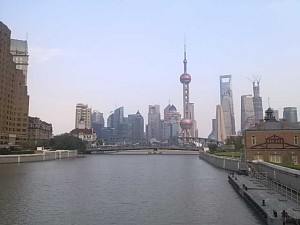Shanghai Street View: Skyline Shaping

Shanghai’s signature Oriental Pearl Tower takes center stage in this week’s Street View, following a much-needed cleaning for the original high-rise in city’s fast-evolving Lujiazui financial district. This concrete and purple glass tower has been the source of controversy since its construction in the early 1990s, winning praise from some for its futuristic look and scorn from others who called it an urban eyesore.
Regardless of what you think, this gaudy, futuristic tower is quickly becoming the center point of a fast evolving Shanghai skyline that represents a new side of the city in sharp contrast with the older and statelier Bund just across the Huangpu River. The Lujiazui area now attracts as many if not more tourists as the Bund itself, both for its own vistas as well as its impressive views of the Bund. That leads me to suggest that perhaps it’s time for city officials to consider finding a catchier and more manageable name for this fast-evolving center that is quickly becoming the new heart of Shanghai.
All that said, let’s step back a moment and look at the latest development in Lujiazui that saw a small army of workers engaged in a massive cleanup to remove 2 decades of grime from the Pearl Tower. The endeavor was the biggest-ever cleaning in China for a building of that size, and took 60 workers 7 months to complete. The crew of “butterfly people” also conducted various maintenance work on the vast structure, which is technically a TV tower but also incorporates 3 big purple balls that each has an observation deck.
I observed the cleanup several times during the process, and the contrast between the older grimier sections and the newly cleaned whiter ones really underscored just how long it’s been since the tower was built, and how radically the skyline has evolved.
I made my own trip to Shanghai as a reporter in 1990, and recall how barren Pudong was at that time shortly after it was declared a special economic development zone. The 468-meter Pearl Tower became the city’s tallest structure and was Lujiazui’s only major building when it was built between 1991 and 1994, and seemed a bit lonely for its first 5 years.
The awkward structure got an important cousin in 1999 when the Gotham-esque Jin Mao Tower opened just down the road. When I first came to Shanghai to work in 2005, the skyline of today was still evolving, with work still yet to begin on the signature World Financial Center, known to many expats as the “bottle opener building”, and the nearby IFC complex. The pending completion of Shanghai Tower this year could finally complete the area’s new skyline for now, since more major development is unlikely due to land subsidence concerns.
I’ll admit I was a bit skeptical when the recent wave of mega-building construction began, but have been pleasantly surprised by the results. The city has been working hard to connect up all the buildings with a series of attractive elevated walkways, and they’ve even added a taxi queue to start addressing the area’s many transportation issues. I’ve also read about plans for a major overhaul of the large green riverfront space to replace the current unimpressive design.
The rapid rise of Lujiazui represents a serious and interesting new challenger to the much older Bund, whose skyline was once one of Asia’s most famous but increasingly seems like a historic relic. I imagine the 2 will ultimately become a complementary pair, with one showcasing the old Shanghai and the other the new.
That brings me back to my original thought, that perhaps it’s time for a catchier, new name with more international flavor to parallel New York’s Wall Street moniker or Hong Kong’s Central. The original name for the Bund was derived from its location on the outer banks of a bend in the Huangpu River, so perhaps a new name could derive from Lujiazui’s spot on the inner bank of that same bend. Perhaps “The Inner Bank” or neitan in Chinese, would fit the bill, in a nod to both the district’s riverfront location and also its growing financial prowess.
